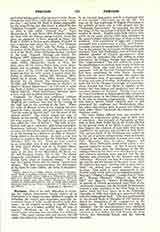

Puritans.—One of the chief difficulties in studying the various movements loosely spoken of as Puritanism is to frame an exact definition capable of including the varied and sometimes mutually inconsistent forms of belief usually classified under that name. In its original meaning it signified “those who strove for a worship purified from all taint of popery” (Maitland, op. cit. inf., 590). A more recent writer adopting and expanding this definition adds: “The many various sects and persons who fall under this definition, were usually characterized both by an aversion from gaiety and by a passionate love of civic freedom” (Trevelyan, op. cit. inf., 60). We may see the first beginnings of English Puritanism in the attitude of those who in 1563 entered into the “Vestiarian Controversy” by opposing the use, by the clergy, of the cap and gown in daily life and of the surplice in church. English exiles from Geneva were active in the cause, and by 1565 their resistance to the queen’s wishes subjected some of them to loss of benefices. This controversy of rights and vestments developed into a controversy of polity, until Presbyterianism emerged in antagonism to Episcopalianism. Yet in the process the movement developed on such divergent lines that Puritanism soon included three different theories of Church government. First there were the moderates who were willing to retain government by bishops, though they preferred the title “superintendent”, but who wished the usages of the Establishment to conform more nearly to Genevan practices. Those who held this system were in agreement with the Scottish Presbyterianism which had been established by John Knox. Secondly there were the strict Presbyterians who wished for the Calvinistic form of government as well as the theology and order of worship. In England the movement was led by Thomas Cartwright of Cambridge, whose doctrine that there should be equality of authority and that bishop and presbyter were all one was soon adopted in Scotland. Thirdly there were the Free Churchmen or Independents who repudiated all coercive power in the Church and wished all men to be free in forming congregations. Their leader was Robert Brown, whose followers were at first persecuted by Anglicans and Presbyterians alike, but whose descendants grew in power and influence until under Oliver Cromwell they became the predominant party.
The three bodies differed from one another in doctrine, in ecclesiastical polity, and in their view of toleration. The strength of Puritanism as common to these three bodies lay in the results effected by the general study of the Bible, in which the Puritans learned the relations of man with God as exemplified in the histories and parables of Holy Writ. This private study of the Scriptures was carried on by the aid of private interpretation which inevitably resulted in the multiplication of minor sects such as Fifth Monarchy men, Levellers, Diggers, and others. Thus Puritanism could never attain a recognized dogmatic system. At first it shared many Calvinistic views with the theologians of the Established Church, but these were abandoned by some and Calvin’s doctrines were rejected first by the Baptists and afterwards by the Quakers and the Unitarians. However, the lack of a consistent theology was the less felt because of the great stress which the Puritans laid upon “serving God in spirit and in truth”—by feeling and conduct rather than by doctrine. This spirit is most pronounced in the Puritan works which achieved the highest popularity: Bunyan’s “Pilgrim’s Progess”, George Foxe’s “Journal”, Thomas Ellwood ‘s “History of My Own Life” and Baxter’s “Saint’s Everlasting Rest”. In matters of Church government some kind of system became necessary and the Scottish Presbyterians evolved a plan, embodied in the First Book of Discipline which had been drawn up in the Edinburgh Assembly of 1560, and which was concerned chiefly with the congregation itself. This was supplemented by the Second Book of Discipline of 1578 which regulated the dependence of the congregation on the higher courts. By it Presbyterianism was fully established; for the superintendents were abolished and all authority was transferred from individual ministers to four bodies, the Kirk Session, the Presbytery, the Provincial Synod, and the General Assembly.
The English Puritans regarded this system from two diametrically opposed points of view. It was approved by the Presbyterians and condemned by the Independents. But for a time they were kept united by the common necessity of opposing the alliance between the High Church party and the Crown which took place under James I. The struggle became political, and the Arminianism, Episcopalianism, and divine right of the sovereign maintained by the one party were opposed by the Calvinism, Presbyterianism, and Republicanism of the other. When the enactments of the Long Parliament had resulted in victory for the Puritans, their own internal differences clamored for settlement and the Westminster Assembly of 1643 was an unsuccessful attempt at composing them. The four parties, Moderate Presbyterians, Scottish Presbyterians, Erastians, and Independents having quarrelled fiercely, agreed on a compromise favoring the Moderates. The Presbyterians, however, gradually lost ground, owing to the growing power of the Independents who had the strong support of Cromwell and his army. They in their turn were destroyed as a political power by the Restoration, since when Puritanism ceased to be a force in England under that name, and survived only in the various Nonconformist sects which have increased and multiplied in number down to the present day, without, however, any augmentation of collective strength. Many of these bodies have long ceased to represent Puritanism in any respect save that of dissent from the Established Church. One of the most picturesque incidents in the history of Puritanism and one of far reaching influence on subsequent American history was the departure of the “Pilgrim Fathers”—seventy-four English Puritans and twenty-eight women—who sailed from England in the May Flower and landed on Plymouth Rock, December 25, 1620. There they founded a colony, representing both types, the Plymouth colony being Congregationalists, the Massachusetts Bay settlers, Presbyterians.
EDWIN BURTON

